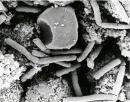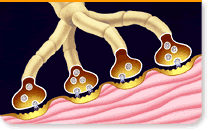
Home Page
About Page
Favorite Links
Custom Page
Whats New Page
Custom2 Page
|
 |
|
BACTERIOLOGY:
BACILLUS CEREUS
POTENTIAL FOOD SAFETY HAZARD
Food poisoning caused by Bacillus cereus may occur when foods are prepared and held without adequate refrigeration for several hour before serving.B.cereus is an aerobic spore forming bacterium that is commonly found in soil, on vegetables, and in many raw and processed foods. Consumption of foods that contain .10000000 B.cereus/g may result in food poisoning. Foods incriminated in past outbreaks include cooked meat and vegetables,boiled or fried rice, vanilla sauce, custards, soups, and raw vegetable sprouts.Two types of illness have been attributed to the consumption of food contaminated with B.cereus.The first and better known is charactrized by abdominal pain and diarrhea; it has an incubation period of 4-16h and symptoms that last for 12-24h. The second, which is charactrized by an acute attack of nausea and vomiting, occurs within 1-5 h after consumption of contaminated food;diarhea is not a common feature in this type of illness .
==CONTROL MEASURES==
B.cereus is a common food contaminant.Efective control measures depend on destruction by a heat process and temperature control to prevent spore germination and multiplication of vegetative cells in cooked, ready-to-eat foods. Measures to reduce or eliminate the threat of food poisoning by B.cereus include :
1)Avoid preparing food too far in advance of planned service
2)Avoid holding cooked foods at room temperature
3)Use quick chill methods to cool foods bellow 7.2C with in 4 hour of prepration
4)store in shallow pans/small quantities with the food less than 4 inches deep ;if food is specially thick ,store no more than 3 inches deep. Hold /store hot foods above 60C until served,
5)Reheat foods rapidly to 74C or above.
|
 BACILLUS
BACILLUS
|
|
SALMONELLA
POTENTIAL FOOD SAFETY HAZARD
Salmonella is arod-shaped,motile bacteri-nonmotile exeptions S.gallinarum and S.pullorum-, nonsporeforming and Gram-negative . There is a wiespread occurence in animals,specially in poultry and swine. Environmental sources of the organism include water, soil, insects, factory surfaces, kitchen surfaces, animalfeces, raw meats, raw poultry, and raw seafoods, to name only a few.
S.typhi and paratyphoid bacteria normally cause septicemia and produced typhoid-like fever in humans. Other forms of salmonellosis generally produce milder symptoms.
Acute synptoms include nausea, vomiting, abdominal cramps, diarrhea, fever, and headache.
Chronic consequences include arthritic symptoms that may follow 3-4 weeks after onset of acute symptoms. Onset of the ilness is usually 6-48h.The infective dose is as few as 15-20 cells;depends upon age and health of host , and strain differences among the members of the genus. Acute symptoms may last for 1 to 2 days or maybe prolonged, again depending on host factors, ingested dose, and strain characteristics.
The disease is caused by penetration and passage of Salmonella organisms from gut lumen in to epithelium of small intestine where inflammation occurs; there is evidence that an entrotoxin may be produced, perhaps within the enterocyte. Foods commonly associated with the disease include raw meats, poultry, eggs, milk and dairy proucts, fish , shrimp , frog legs, yeast, coconut, sauces and salad dressing, cake mixes, cream filled desserts and topping, dried gelatine, peanut butter,cocoa and chocolate.
Various Salmonella species have long been isolated from the outside of egg shells. The present situation with S.enteritidis is complicated by the presence of the organism inside the egg, in the yolk. This and other information strongly suggest vertical transmission,i.e., deposition of the organism in the yolk by an infected layer hen prior to shell deposition. Foods other than eggs have also caused outbreaks of S.enteritidis disease.
==CONTROL MEASURES==
Hazards from Salmonella can be prevented by: heating seafood sufficiently to kill the bacteria (e.g. 24s at 65f), holding chilled seafood below 4.4c, preventing post-cooking cross-contamination and prohibiting people who are ill or are carriers of Salmonella from working in food operations.
|
|
CAMPYLOBACTER SPP.
POTENTAIL FOOD SAFETY HAZARD
Campylobacter is considered by many to be the leading cause of entric illness in the United States. Campylobacter species can cause mild to severe diarrhea, with loose, watery stools often followed by bloody diarrhea. C.jejuni, C.coli, C.lari account for more than 99% of the human isolates(C.jejuni 90%). Other species have been associated with human illness in recent years.
Campylobacter species are highly infective. The infective dose of C.jejuni ranges from 500 to 10,000 cells, depending on the strain, damage to cells from environmental stresses, and the susceptibility of the host.Only the mesophilic C.fetus is normally invasive.
Thermophilic species (optimum 42C) such as C.jejuni are accasionally invasive. The infections are manifested as meningitis, pneumonia, miscarriage, and a severe form of Guillain-Barre syndrome. Thermotolerant strains of C.fetus that grow at 42C have been isolated from patients.
Campylobacters are carried in the intestinal tract of a wide variety of wild and domestic animals, specially birds. They can establish a temporary asymptomatic carrier state, as well as illness, in humans.This is specially prevalent in developing countries.Consumption of food and water contaminated with untreated animal or human waste accounts for 70% of Campylobacter-related illnesses each year.The foods include unpasteurized milk,meats, poultry, shellfish, fruits, and vegetables.
C.jejuni can survive 2-4 weeks under moist,reduced-oxygen conditions at 4C, often outlasting the shelf life of the product (except in raw milk products).They can also survive 2-5 months at -20C, but only a few days at room temperature. Environmental stresses, such as exposure to air, drying, low pH, heating, freezing,and prolonged storage, damage cells and hinder recovery to a greater degree than for most bacteria. Older and stressed organisms gradually become coccoidal and increasingly difficult to culture. Oxygen quenching agents in media such as haemin and charcoal as well as a microaerobic atmosphere and preenrichment can significantly improve.
Campylobacters are microaerophilic, very small, curved, thin , Gram-negative rods (1.5-5 mic.g), with corckscrew motility. They often join to form zigzag shapes. Campylobacter spp. are currently identified by tests described by Harvey (1980) and Barret et al.(1988).PCR genus and species identification methods have been published.
***CONTROL MEASURES***
Hazards from C.jejuni can be controlled by thoroughly cooking seafood and by stressing the importance of proper (and frequent) hand and equipment washing and sanitary food-handling practices. Since the infective dose of C.jujuni is thought to be small, time/temperature abuse of food products could result in this illness.
***FDA GUIELINES***
FDA to assess situations on a case by case basis.
WHAT CHARACTERISES HYPERACTIVE MUSCLE CONTRACTION?
At a normal neuromuscular junction, a nerve impulse triggers the release of acetylcholine, which cause the muscle to contract.
Hyperactive muscle contraction, regardless of the underlying cause, is characterised by excessive release of acetylcholine at the neuromuscular junction.
The use of botolinum toxin (BOTOX) can be effective in reducing this excessive activity.
|
|

WHAT IS *BOTOX* ?
Botox is the trade name for botulim toxin. In 1973 botox was used as a treatment for patients with crossed eyes.
By weaking the overactive eye musceles this medicine provided an alternative to surgery.
Following this breakthrough botox quickly gained acceptance for other eye conditions.
Since then it has been used extensively by specialists to treat many medical conditions.
Botolinum toxin (Bot.Tox) is a purified toxin produced by a bacterium called Clostridium Botolinum. It has been used safely in ophtalmology over 10 years, to treat conditions such as strabismus and blepharospasm. botox blocks impulses from the nerve to the tiny facial muscles that are related to expression lines. botox relaxes the muscles so they do not contract .
after treatment, the overlying skin remains smooth and unwrinkled, while the untreated facial muscles contract in a normal fasion, allowing normal facial expression to be unaffected.
***WHAT BENEFITS CAN I EXCEPT?***
Based on controlled clinic trail data, after treatment with BOTOX for hyperhydrosis of the axillae,11% of patients would be expected to experience an adverse reaction.
In the management of axillary hyperhidrosis, percieved increase in non axillary sweating was reported in 4.5% of patients within 1 month after injection and showed no pattern with respect to anatomical sites affected. resolution was seen in approximately 30% of the patients with four months. Weakness of the arms has been reported uncommonly (0.7%) which was mild, transiet, did not require treatment and recovered without sequelae. This event may be related to treatment, procedure or both.
The majority of people (82.5%)reported an improvement in the lines between their brows after a week.
After 30 days, 89% of people rated the improvement in frown lines as moderate or better.
Results can last up up to 6 months.
|
|